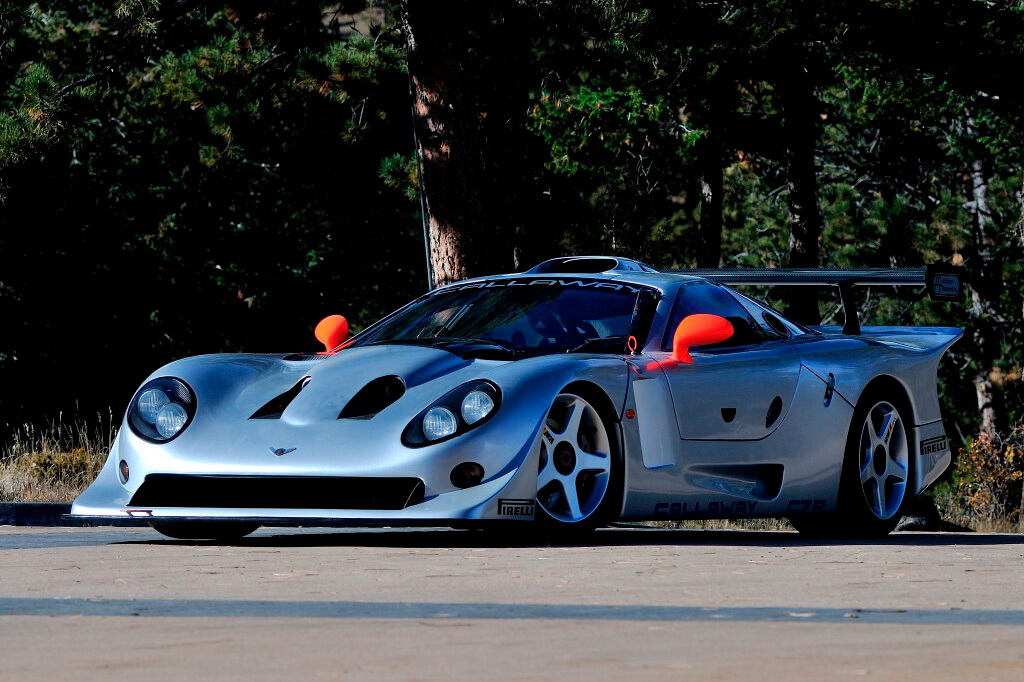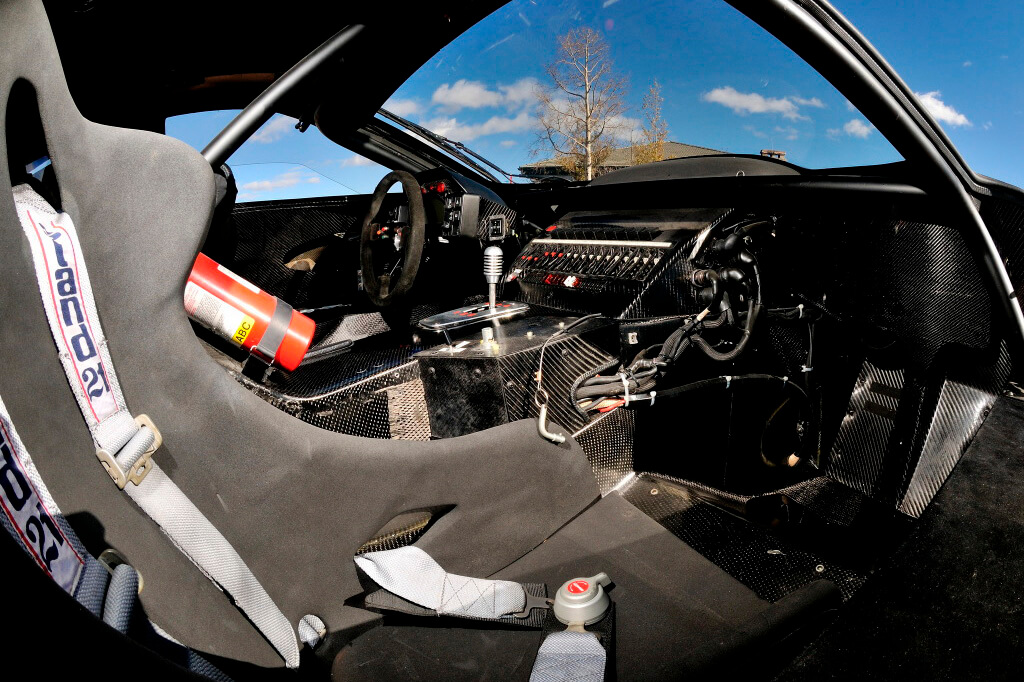Callaway C7R GT1
Description
In 1997, Callaway Cars released the GT1 version of its Corvette LM for sports car racing, the first car built almost entirely by Callaway. It looks like it's based on a road car, but there was no road version, so the body shape is technically a prototype.
Development was carried out taking into account the 1994-95 GT1 class rules, but delays in production meant that the Callaway C7R racer's first start occurred in pre-qualifying for the 1996 24 Hours of Le Mans. Unfortunately, due to several minor errors, both Callaway C7Rs failed to qualify for the race. Upon returning to Callaway Competition's German base in Liengarten, the company continued testing and developing the C7R in preparation for the 1997 season. However, the appearance of this car at Le Mans led to the fact that the French race organizers decided to change the regulations of the GT1 class, fearing that such cars would move this class too far away from the real road supercars that, logically, should compete in it.
New requirements required significant changes to the design of the C7R, so that by the start of the 24 Hours of Daytona in 1997, the team had only one ready car, which they entered at the start, driven by Boris Said, Ron Fellows, Johnny Unser and Enrico Bertagia. Its handling and aerodynamic characteristics made a huge impression on the pilots. Having qualified in 25th place (the car was damaged in an accident in the practice session before the race and was unable to show the best result), the drivers quickly rose to the top ten in the overall standings and leadership in the GT1 class. Alas, in the middle of the 24-hour race, electrical problems forced the drivers to leave the track, so that in the end they took only 54th place out of 80. They failed to start at Le Mans in 1997 again – the FIA once again rewrote the rules of the GT1 class, eliminating the possibility participation in the race for Callaway, which never produced a road version of the C7. However, successfully developing such a complex project remains a major achievement for a small company. After the update, the sports car was redirected to conquer the 1997 Rolex 24 Hours of Daytona race in the team of Johnny Anzer. As a result, in the January test races, the 13th qualifying place was achieved (3rd in its GTS-1 class), but in the race itself, 3 weeks later, the car retired on 331 laps out of 690, receiving 54th place in the overall standings and 15th in class.
The C7R engine is a heavily modified version of the LT5 from the Corvette ZR-1. It was first used by Callaway Cars in the SuperNatural Corvette, where it was available with up to 470 horsepower. For the C7R, power was increased to 640 hp. using a supercharger. The 6.3-liter V8 engine was mounted mid-mounted at the front, hence the extremely long hood, and the 6-speed transmission was mounted in the rear to distribute weight evenly.
The C7R's structure was a monocoque with carbon fiber panels. The appearance was created by Paul Deutschman. Its aerodynamic design cuts through the air while generating high-speed downforce greater than the vehicle's weight, resulting in superior handling and stability while keeping weight to a minimum.
Since the C7R was built for racing, the interior was quite spartan - carbon fiber all over.
Only two examples of the Callaway C7R were built. One of them is currently owned by company founder and owner Reeves Callaway. Another is theoretically on the market, but at a 2014 Kissimmee auction it failed to reach $150,000 and was not sold.
Sources
Specification
| Bodywork | |
|---|---|
| Years of production |
1995-1997
|
| Body type |
купе
|
| Number of doors |
2
|
| Number of places |
2
|
| Engine | |
|---|---|
| Engine type |
бензиновый
|
| Engine location |
спереди, продольное
|
| Engine model |
Callaway Supernatural (LT5 V8)
|
| Cylinders |
V8
|
| V-angle |
90°
|
| Capacity (cc) |
6267
|
| Power output (hp / kW /) |
640 /
477 /
|
| at rpm |
6250
|
| Torque (N·m) |
835
|
| at rpm |
5400
|
| Bore (mm) |
105,0
|
| Stroke (mm) |
98,4
|
| Compression |
10,0
|
| Number of valves |
2/16
|
| Valvetrain |
OHV
|
| Block material |
алюминиевый сплав
|
| Fuel system |
многоточечный впрыск
|
| Turbocharger |
да
|
| Specific | |
|---|---|
| Specific output (hp/litre) |
102,12
|
| Specific output (hp/tonne) |
640,00
|
| Specific output (kg/hp) |
1,56
|
| Specific torque (N·m/litre) |
133,24
|
| Specific torque (N·m/tonne) |
835,00
|
| Transmission | |
|---|---|
| Driven wheels |
задний
|
| Gearbox |
механическая
|
| Number of speeds |
6
|
| Suspension | |
|---|---|
| Front suspension |
независимая на двойных поперечных рычагах
|
| Rear suspension |
независимая на двойных поперечных рычагах
|
| Elastic elements in front |
пружины
|
| Elastic elements in rear |
пружины
|
| Front anti-roll bar | |
| Rear anti-roll bar | |
| Wheels brand |
RW Wheels
|
| Tire brand |
Pirelli P Zero
|
| Tyres front |
295/35 R18
|
| Tyres rear |
345/35 R18
|
| Steering | |
|---|---|
| Steering type |
шестерня-рейка
|
| Power steering |
гидравлический
|
| Brakes specs | |
|---|---|
| Brakes front |
дисковые вентилируемые
|
| Brakes rear |
дисковые вентилируемые
|
| Brand of brakes |
Brembo
|
| Dimensions and weight | |
|---|---|
| Body |
монокок с панелями
|
| Body material |
углеволокно
|
| Length (mm) |
4200
|
| Width (mm) |
1990
|
| Height (mm) |
1070
|
| Wheelbase (mm) |
2620
|
| Curb weight (kg) |
1000
|
| Max. weight (kg) |
1400
|
| Weight distribution (%) |
45/55
|
| Performance specs | |
|---|---|
| Fuel tank capacity (l) |
120
|
| Dynamic specs | |
|---|---|
| Acceleration 0-100 kph (s) |
4,1
|
| Acceleration 0-60 mph (s) |
4,0
|
|---|
| Top speed (kph) |
330
|
|---|---|
| Top speed (mph) |
205
|



